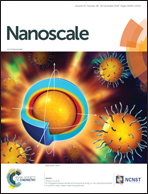Peptide-directed encapsulation of inorganic nanoparticles into protein containers†
Abstract
Biomolecules can be combined with inorganic compounds to unite biological features with the chemical and physical properties of abiotic materials. In particular, protein containers, with their inherent ability to encapsulate cargo molecules, are perfect platforms for the generation of multifunctional assemblies. However, encapsulation of foreign cargo is immensely challenging due to the lack of specific interactions between cargo and container. Here, we demonstrate that the highly specific cargo-loading mechanism of the bacterial nanocompartment encapsulin can be employed for encapsulation of artificial cargo like inorganic nanoparticles. For this purpose, container-filling gold nanoparticles were decorated with a small number of encapsulin cargo-loading peptides. By lock-and-key interaction between the peptides and the peptide-binding pockets on the inner container surface, the nanoparticles are encapsulated into encapsulin with extremely high efficiency. Most notably, peptide binding is independent from external factors such as ionic strength. Cargo-loading peptides may serve as generally applicable tool for efficient and specific encapsulation of cargo molecules into a proteinaceous compartment.



 Please wait while we load your content...
Please wait while we load your content...